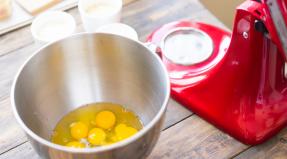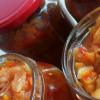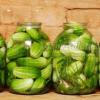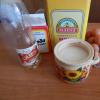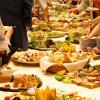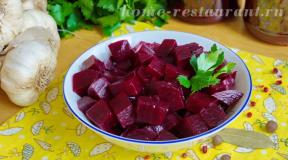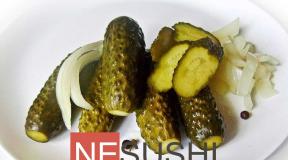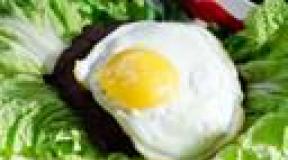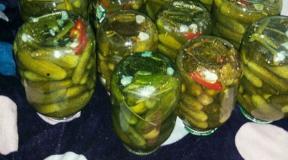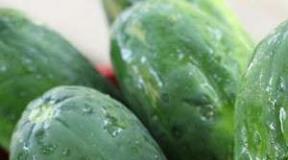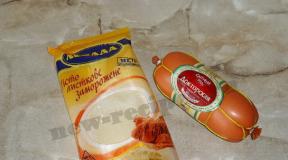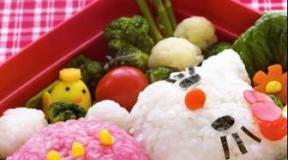How to make colors for the cake from the products. How to make a natural food dye blue? How to get a natural blue dye
Proper dessert pleases the eye and awakens the appetite with one of its kind - just add a few bright colors. This is where colored creams for dyes-free cakes come to the rescue.
From scratch
For decorating homemade cakes, pastries and other pastries, you can use a variety of. Effectively looks and well holds the shape of the air protein cream. To make it, egg whites are separated from the yolks, a pinch of salt is added, some citric acid is added and whipped into a strong foam. In the resulting mass is gradually injected sugar or icing sugar. Very popular various oil creams. The easiest is made from butter with the addition of egg yolks, powdered sugar and water. You can replace the eggs with condensed milk, and you get no less appetizing decoration. Very tasty and fast cream is made from sour cream with fat content of at least 35%, powdered sugar and vanilla.
How to prepare a cream without dye to decorate the cake, or rather, without synthetic coloring additives? To do this, you need to investigate the stocks of products in the kitchen that will serve us with natural dyes. Having processed them in a certain way and mixed with cream, you will get the original color cake decoration, tasty and absolutely harmless.
Sun on the cake
Bright yellow color can be obtained in many different ways. The easiest is to add some fresh carrot juice or raw egg yolk to it. Saffron and turmeric have a rich yellow color. To make them a natural dye, you need to carefully chop the seasoning, dilute it in water and insist for a day. After which the mixture can be added to the cream. Rainbow yellow shade gives lemon peel. To do this, finely grate it on a grater, wrap in cheesecloth and squeeze the juice. Juice of yellow buckthorn fruit can also be used as a natural dye.
All shades of red

Persistent coloring properties of beets are well known. By adjusting the saturation of its juice, you can easily make a great cake without dyes at home, from pink to deep red. To do this, grate a small beet grated, pour it with water and cook for an hour. To make the color intense and beautiful, add a pinch of citric acid to the broth. Do not forget about all kinds of berries of red shades: raspberries, strawberries, lingonberries, currants, cranberries, dogwood. By the way, jams, jams and syrups based on them can be used to create creams of red shades with the same success. Cherry and pomegranate juices also perfectly cope with the task. And the red wines will give the cream for the cake not only a pleasant color, but also exquisite aromatic and flavor notes.
Orange joy
Carrots not only have a rich orange color, but also generously share it with others. To do this, rub it on a grater and fry a little in butter in a ratio of 1: 1. As soon as the carrots soften enough and the oil turns orange, remove the pan from the stove and let it cool. Next, we shift the resulting mass in gauze and carefully squeeze - the natural dye is ready. You can resort to using orange and paint the cream with fresh citrus juice or chopped zest. And you can experiment with the already mentioned yellow and red dyes and mix them with each other.
Sweet cool

How to make cream for cake in cold colors? Blue and purple shades give the juice of blueberries, blackberries and grapes rich dark varieties. A decoction of the leaves of red cabbage will allow you to get light blue shades. As a dye, you can use eggplants. First you need to freeze them a bit, carefully cut off the skin and squeeze juice out of it.
Green vegetables, there are many, and the best coloring properties has spinach. Pass it through a meat grinder or wrap it in a clean gauze and squeeze it properly, and you will get a natural dye of pale green color. Want to achieve a more intense shade? Squeeze the juice from the spinach and boil it for half an hour.
Chocolate palette
The easiest way to get a noble brown color is to mix the cream with regular coffee, cocoa powder or melted chocolate. However, you can resort to a more sophisticated method - using burnt sugar. To do this, sugar is diluted in water in a ratio of 5: 1, pour the mixture into the pan and put on a small fire. Maintain weight on the stove until it acquires a rich brown color. Then remove it from the heat and trickle in a little more water. Then carefully filter the resulting dye. The main thing is not to overdo the sugar, otherwise it forms hard lumps.
As you can see, making a cream without a dye for the cake is quite simple. And most importantly, you can do without harmful artificial additives. This decoration will surely appeal to all your households, especially little sweets.
Baking, decorated with colored cream, not only pleases the eye, but also stimulates the appetite. Often the housewives add to the cream artificial colors purchased in the store.
However, the abuse of products of non-natural origin can adversely affect health.
I propose to prepare dyes at home, using the juice of some plants and other ingredients borrowed from nature.
Today you will learn how to make a green cream cake (or blue), as well as learn how to make various natural dyes with your own hands.
How can you decorate the cake with butter cream
Baking a cake for a significant event is not a simple matter. But you can cope with it, if you show imagination and follow the recommendations of the guru of confectionery art. To get started, stock up with the necessary ingredients.
50 g of condensed milk (manufactured according to GOST); 0.5 pack of butter (good quality); vanilla - pinch.
Cooking:
- Oil soften. You can cut it into pieces and leave at room temperature for 40-50 minutes. Another way, it is faster, involves the use of a microwave oven, where the oil will be ready in 2-4 minutes.
- Using a mixer, beat the softened butter, do not forget to add vanilla.
- Pour the condensed milk in stages to obtain the desired consistency. It is possible that the stated amount of condensed milk will be too much.
Sweetness to the cream for the cake will give condensed milk, but with a touch you need to work separately. If you want to give the cream a chocolate color, add cocoa powder.
The intensity of the color depends on the amount of powder, and it is in your power to change it both up and down.
The finished cream can be put in a pastry bag with a suitable nozzle. But if not, use the tools at hand and build something like this.
For example, from a dense plastic bag. It is enough to fill it with cream, and then cut off the corner.
You will get a small hole through which you will squeeze out blue or any other colored cream for dessert, making various inscriptions or other elements.
A good support in the work will be a rotating stand. You will not need to be distracted by turning the dish with the cake in different directions.
With a flick of the wrist, you can quickly turn the dessert and apply the next element with the cream.
How can you decorate the cake with protein cream
Decorations for a protein cream cake are equally beautiful and elegant. The main thing you need to remember is the absolute purity of the dishes and appliances involved in the preparation of the cream.
First of all, separate the whites from the yolks. In order not to spoil the whole batch of eggs, break each unit over a clean cup, and only then pour the protein into a common bowl.
It is advisable to send the proteins in the refrigerator, they are better whipped at a low temperature.
Whip and dishes, in which you will beat the cream, pre-wash and pour boiling water.
The slightest trace of fat will not allow you to achieve pomp, which means that your work will be in vain. Water drops on the dishes are also unacceptable; after processing, carefully wipe the bowl and the whisk with a paper towel.
In the process of whipping, add a pinch of salt and soda to the proteins. It saves both time and your strength. In addition, citric acid will make the mixture is not so sugary.
You can decorate the dessert white-white protein cream, it will look festive and elegant. Some confectioners prefer to paint a lot, because the flowers in the natural environment are the most incredible shades.
What can make natural dyes at home
Given the consumer demand, professional confectioners decorate desserts with cream roses and inscriptions of different colors.
In their kitchen, housewives can use the blue dye purchased in the store. But is it safe for health?
Let us turn to the experience of our grandmothers, who managed to make dyes from the available products. How and from what they did it, we now understand.
The easiest and easiest way to color the cream is to add boiled juice of some vegetables, berries or fruits to it.
It is known that green color is obtained due to the presence of spinach juice, orange - carrots. Beetroot gives red color, and turmeric - yellow.
By combining colors with each other, you can get other shades. For example, combining yellow and green dye, you get a blue tint, which is also often used to decorate desserts.
Remember that beets will not give the cream a bright red color. Even if it is boiled, and the broth is mixed with a small amount of vinegar or citric acid, the result will be a brown shade or fuchsia.
Before using the carrots, finely chop and paste a few minutes in butter. Rubbing the mass through a sieve, add to the cream, and you will receive a carrot-colored decoration.
A rich orange tint will give you not carrots, but orange peel. In this you will see when a piece of sugar rub on the rind of this citrus.
Sugar crystals quickly absorb aromas and any dye. Experiment with lemon, lime, and you will see how the sugar gets a new color. By the way, orange can be achieved with the help of apricot, cooked in syrup.
Turmeric, or rather its saturated aqueous solution, will make the cream not bright yellow, it will contain a greenish tint.
If the decoration needs to give it a sunny yellow color, use saffron. An alternative to saffron would be sea buckthorn or pumpkin.
Red or deep-pink dye is obtained due to fresh or frozen berries of raspberry, cranberry or lingonberry.
Strawberries, despite the bright color, will give the cream an ugly brown-red tint. Cherry juice mixed with cream will give it a cold red with a purple tint, Kohler.
If you need to get a thick purple dye with ink saturation, use blackberries.
Add black currant syrup to the protein mass before baking, resulting in soft blue meringue.
A couple of drops of syrup will be enough to color the dessert in a nice color. The saturation of the hue depends on the amount of dye, adding it more than usual, you get a blue color.
Blueberries and blueberries will give you purple or cold lilac.
Gentle cream shade is obtained by adding tomato paste. If you increase its concentration, the decoration of the cream will get a delicate orange shade.
Do not be afraid, the dessert will not acquire the taste of tomatoes, the amount of dye is too small to affect anything other than color.
The shade of spring greens will give spinach, it is the leader among green natural dyes. It has a neutral taste, which means that your dessert, as well as before decorating with cream, will be sweet and thinner vanilla flavor. An alternative to spinach is tarragon (tarragon) and mint leaves.
Brown dye is cocoa powder, melted chocolate and a saturated solution of coffee (it can be either soluble or ground).
How to make dyes at home
Syrups of different berries can be cooked in advance and keep them in the refrigerator in a well-closed container. If necessary, use to give the desired shade.
Frozen products are also used. It is only necessary to defrost the berries, cover them with sugar (1: 1 ratio) and boil them over low heat. Mass strain.
Rinse and chop the spinach. Pour with a small amount of water and blanch for 5 minutes over low heat. Green solution drain.
Peel the beets and cut into slices. Boil 15-18 minutes in water and add a few crystals of citric acid. Use filtered solution.
Mint and tarragon do not need to cook, otherwise they will become brown. First, prepare a hot sugar syrup, add chopped herb into it and let it brew.
Pumpkin, as well as carrots, chop and paste in butter before using.
When you can add natural dyes
Pumpkin, carrot and saffron dye should not be added to the dough before baking (this does not apply to meringues and macaroons.
It is better to soak the finished cakes with syrup so that the dessert will get the desired shade (green, blue, pink, red and others).
Natural dyes are not introduced into the cream before whipping, because they do not contribute to the process. Add them at the very end and in the quantity necessary to obtain the desired shade.
Multi-colored dough for dumplings, ravioli prepared with dyes, previously dissolved in water. It is necessary for uniform distribution throughout the mass.
My recipe video
Dyes from natural ingredients. How to do them correctly and how to use in everyday life?
Cakes, pastries, marmalade and other goodies look, of course, very beautiful and appetizing in tandem with bright synthetic dyes, but it is harmful and even dangerous to health. Natural dyes can be useful anywhere. Of these, children's cakes are often made, on which various figures of cartoon characters made of mastic flaunt on top.
Dyes of this kind are also used to create finger paints for children; they can also be drawn by adults who are allergic to the components of ordinary paints. In our article we will talk about how you can make dyes at home, which will not only give a beautiful shade to food, but also make them more useful. And children's creativity with such dyes will turn into a safe and useful game.
How to make a natural food dye, red natural dye
The leading role of all products with a red tint is beet. From this popular vegetable in our country, you can get natural and healthy dyes from a delicate pink shade to a rich purple color.
Dye based on this bright root is prepared according to several recipes. We will talk about the method of digesting dye from beets, and also tell you about the express way to get the desired color from the beet mass.
So first, let's talk about a quick way to get red paint. To do this, your blender will hasten to the rescue. Just throw a couple of little beets into the bowl of this miracle combine. But pre-wash the vegetable with diligence. You can use a metal sponge for this purpose, with it you can perfectly wash the beets.
 Washed beets cut with a knife into small pieces. To the beet in a blender, pour in and a half cup of clean water. Then turn on the blender and chop the root vegetables into a puree. Then move the mush to gauze and squeeze the juice. Here you have a biologically pure dye, congratulations!
Washed beets cut with a knife into small pieces. To the beet in a blender, pour in and a half cup of clean water. Then turn on the blender and chop the root vegetables into a puree. Then move the mush to gauze and squeeze the juice. Here you have a biologically pure dye, congratulations!
Now tell about the second method of obtaining the dye from beets. First, wash the root and remove the skin from it. Then cook grater and grate large beets. After this manipulation, move the beet pulp into a saucepan and cover with water so that the beets are just hiding there.
Now start cooking vegetable-dye. The fire should be small. Make sure that the lid on the saucepan is tightly closed. Boil the beets for an hour. In order for the dye to not become less bright, throw into the saucepan in the process of cooking half a teaspoon of "lemon".
 After an hour, turn off the fire, and open the lid on the saucepan. Allow the dye to cool, and then use it for its intended purpose. Cake from beets can be separated using gauze or strainer.
After an hour, turn off the fire, and open the lid on the saucepan. Allow the dye to cool, and then use it for its intended purpose. Cake from beets can be separated using gauze or strainer.
Another red color eco dye can be obtained from berries such as raspberries, cranberries, cherries and so on. Pomegranate juice can also be a great coloring agent. These products can not cook. It is easier with him. Just squeeze out the juice and start painting.
 Be careful. In the process of extracting juice from beets, pomegranates or berries, you can so dirty your hands that it will be impossible to wash them with simple soap and water. Therefore, we recommend using ordinary thin rubber gloves as a protective uniform. They can often be found in the hands of cooks.
Be careful. In the process of extracting juice from beets, pomegranates or berries, you can so dirty your hands that it will be impossible to wash them with simple soap and water. Therefore, we recommend using ordinary thin rubber gloves as a protective uniform. They can often be found in the hands of cooks.
If your hands are still dirty, and now they need to be immediately washed, resort to the help of citric acid. Just dissolve the bag of "lemon" in a deep bowl with hot water, and then lower your hands there. You'll see, beet juice is washed quickly.
How to make green food dye
The king of biologically pure green shades is spinach. With it you can get both the rich color of greenery, and the gentle color of young grass.
 If you want to dye products in a light green color, reminiscent of spring greens, then spinach will squeeze enough juice. To do this, wash the leaves of spinach and turn them in a meat grinder. Then fold it over the gauze, substitute the bottom plate for collecting juice and press harder. The juice will instantly flow. He is completely ready to use it in the kitchen.
If you want to dye products in a light green color, reminiscent of spring greens, then spinach will squeeze enough juice. To do this, wash the leaves of spinach and turn them in a meat grinder. Then fold it over the gauze, substitute the bottom plate for collecting juice and press harder. The juice will instantly flow. He is completely ready to use it in the kitchen.
If you want to achieve a rich green color, then this juice, along with chopped spinach, you need to boil down. To do this, move the green mass twisted in the meat grinder into a saucepan or a large iron mug and put on a slow fire. Boil down it for about 40 minutes. You will see how the juice gradually begins to become more intense in color. Then cool it, strain it through a fine sieve or gauze cloth and use it in cooking.
How to make a blue food dye
If you already have other natural food dyes in your arsenal, you can get blue color by mixing green and red hues. Yes, yes, the very ones that we made from beets and spinach. If there is no such, then go to the store for red cabbage, and then proceed to the creation of blue eco paint in your kitchen.
 Excellent blue color can be obtained from red cabbage. Chop it or just cut it into pieces. Then put in a saucepan and pour the same water. Do not pour liquids very much. Just let the cabbage lightly cover with water.
Excellent blue color can be obtained from red cabbage. Chop it or just cut it into pieces. Then put in a saucepan and pour the same water. Do not pour liquids very much. Just let the cabbage lightly cover with water.
Boil the vegetable for half an hour. After opening the cap after 30 minutes, you will see that the water has turned blue. If you want to achieve a more saturated color, throw a spoon of baking soda into the water, the water will immediately become brighter. Hold the cabbage in water until it cools completely, and then drain the resulting natural paint into a separate container to use it later for any purpose.
 If you need blue with a shade of purple, then ordinary eggplant will come to the rescue. To meet him on the shelves of supermarkets is not a problem at all. First place the "blue friend" from the bed in the freezer. Let him lie there for about half an hour.
If you need blue with a shade of purple, then ordinary eggplant will come to the rescue. To meet him on the shelves of supermarkets is not a problem at all. First place the "blue friend" from the bed in the freezer. Let him lie there for about half an hour.
Then remove from the vegetable "clothes" in the form of a peel. Then move these eggplant crusts to a blender and turn it into a mush. And after this operation, squeeze the juice out of them, using gauze.
 Blueberry can give a blue-violet tint. Well, if you want to get such a dye in the summer, during the ripening of this berry-paint. Take a half cup of fresh berries and mix with a quarter cup of water. Then wipe with a fork carefully to get a homogeneous gruel.
Blueberry can give a blue-violet tint. Well, if you want to get such a dye in the summer, during the ripening of this berry-paint. Take a half cup of fresh berries and mix with a quarter cup of water. Then wipe with a fork carefully to get a homogeneous gruel.
After that, it is better to wear gloves on your hands so that the skin does not turn blue. Blueberry juice is very hard to wash off from the hands, and it is unlikely to even wash out from clothes. So, armed with protective seals, move the porridge from blueberries on the gauze and squeeze the juice pressing movements.

How to make black food dye
Do not do in the process of cooking, say baby cake, and without black paint. For example, creating heroes, from any cartoon on a cake, the culinary specialist draws black eyes, a nose and some items of clothing. For boys, they often make cakes with a soccer ball. Of course, even here you cannot do without black natural dye.
 Cocoa plays the role of a black colored pigment among the products. But do not think that this is the usual sort of this drink. Cocoa should be bought only special, varieties "Dutch Ultra." This cocoa has a darker color than its peers. The dye made from such cocoa is black.
Cocoa plays the role of a black colored pigment among the products. But do not think that this is the usual sort of this drink. Cocoa should be bought only special, varieties "Dutch Ultra." This cocoa has a darker color than its peers. The dye made from such cocoa is black.
To obtain the desired shade, simply mix a couple of spoons of cocoa with a little water and heat it up. And then the cooled mixture can be used to paint something. Another black color can be obtained from cuttlefish ink, but in this case the salty taste of this biological dye is transferred to the dish.

How to make a yellow food dye
Give the dough, cream or something else yellow color will help spice called turmeric. It can be found on the shelves of the store, packaged in bags. This spice has a tangy flavor with hints of orange.
To make an eco dye, mix a tablespoon of this colorful spice with a glass of water. Then put this mixture on the fire and boil for a couple of minutes. Next, leave it to cool. When the mixture becomes cold, you can use as intended.
 Remember that turmeric "likes" to color is not what is necessary. For example, clothing, skin, furniture, the floor, and so on can suffer from it. Everything that comes into contact with this miracle spice is painted in a sunny color. Therefore, take precautions when working with such a natural dye. And it is worth noting that such a dye is stored in the refrigerator, in a closed jar for no more than 15 days.
Remember that turmeric "likes" to color is not what is necessary. For example, clothing, skin, furniture, the floor, and so on can suffer from it. Everything that comes into contact with this miracle spice is painted in a sunny color. Therefore, take precautions when working with such a natural dye. And it is worth noting that such a dye is stored in the refrigerator, in a closed jar for no more than 15 days.
Pale yellow color can be obtained from citrus. Or rather, you will need a lemon for this purpose. Take a large fruit and wash it under running warm water. Then cook the grater with small holes. Grate the lemon zest, then put it on the gauze and squeeze the juice. You will get a fragrant and very gentle, sunny shade of yellow.
 There is another option for the extraction of yellow natural dye. This time saffron will be used. Just chop it with a knife or with a blender. then pour a small amount = m of vodka and put in a dark place for a day. It is best to choose a glass jar with a tight lid as a container.
There is another option for the extraction of yellow natural dye. This time saffron will be used. Just chop it with a knife or with a blender. then pour a small amount = m of vodka and put in a dark place for a day. It is best to choose a glass jar with a tight lid as a container.
 As the day passes, remove the jar and strain the mixture in it. Then use this yellow tincture for cooking or coloring something at your discretion. Vodka will give dishes a savory taste and delicate aroma. For children's paints, of course, it is better not to use such a dye, but to replace it with a non-alcoholic variant.
As the day passes, remove the jar and strain the mixture in it. Then use this yellow tincture for cooking or coloring something at your discretion. Vodka will give dishes a savory taste and delicate aroma. For children's paints, of course, it is better not to use such a dye, but to replace it with a non-alcoholic variant.
How to make a blue food dye
Natural food-grade blue dye can be obtained by diluting the blue dye we extracted from red cabbage with milk. Just add a few spoons of milk to the juice obtained from boiling the cabbage.
 Adjust the intensity at your discretion. If you need a rich blue. then do not pour a lot of milk, and if you need a slightly bluish tint, then pour in more milk.
Adjust the intensity at your discretion. If you need a rich blue. then do not pour a lot of milk, and if you need a slightly bluish tint, then pour in more milk.
How to use natural food colors:
In tinting food and creating cakes with homemade dyes, you need to know certain subtleties.
for cream
If you use a natural eco dye as a cream color, then add paint at the end of cooking. Do not pour in the dye before whipping. Otherwise, you can not achieve the desired consistency of the cream. During whipping dye can only interfere.
 Do not immediately put a lot of dye in order to achieve the rich color of the cream. As soon as you whisk the cream in, drip a little of the coloring fluid, mix gently and see what color the product is. Basically, a few drops of food paint are enough to make the cream “dress” in the shade you need.
Do not immediately put a lot of dye in order to achieve the rich color of the cream. As soon as you whisk the cream in, drip a little of the coloring fluid, mix gently and see what color the product is. Basically, a few drops of food paint are enough to make the cream “dress” in the shade you need.
for meringue
If you are cooking meringue, the dye, too, pour in the very last and very carefully. Note that the meringue is rarely painted, it is in white and asks in the mouth. If we warned that you need to be careful with the cream, so as not to harm the consistency, then you should be even more careful with the meringue. An extra drop of liquid can not play in favor of beautiful and delicious meringue.
 First whip the protein with sugar. Usually taken for every 50 grams of sugar 1 is a large egg protein. Remember that sugar should be poured gradually to make the meringue tender and lush, without sugar crystals in its composition. At the end of cooking, when you don’t feel the sugar on your teeth, you can add a dye, but very carefully. Droplets of paint will be enough.
First whip the protein with sugar. Usually taken for every 50 grams of sugar 1 is a large egg protein. Remember that sugar should be poured gradually to make the meringue tender and lush, without sugar crystals in its composition. At the end of cooking, when you don’t feel the sugar on your teeth, you can add a dye, but very carefully. Droplets of paint will be enough.
for sponge cake
If you bake the cake yourself and want to decorate the cakes for him, then it is better to do this when the cake has already been removed from the oven, and not at the time of kneading the dough. This is especially true of various intense colors, such as red, blue, green. But yellow or brown can be added to the dough and in the process of kneading.
 Often cocoa is added to the dough during kneading to make the cake brown. Prescription is done this way when baking a zebra cake. Cocoa is put into one part of the dough in this recipe, and nothing is added to the other and it remains white.
Often cocoa is added to the dough during kneading to make the cake brown. Prescription is done this way when baking a zebra cake. Cocoa is put into one part of the dough in this recipe, and nothing is added to the other and it remains white.
Then one by one, pours onto the baking tray, then the second parts of the dough and a circle are drawn with a fork or knife. In the end, you get a beautiful striped cake.
The use of natural food dyes in drawing
Natural dyes are widely used in creativity. For example, often based on home dyes make finger paints for children's creativity. They differ from the purchase that they can eat. Agree, after all small children all pull in a mouth to try on a tooth. You can paint with finger paints from 6 months, as soon as the baby starts to sit.
 With such natural colors you will be calm for the health of your child. Even if, in the process of his creative impulse, he will taste paints, then this will not harm his health, because there is no chemistry there. On the contrary, if you pick up the colors with regard to the child's eating habits, you can get 2 in 1, that is, a full snack or snack, and the needs of the child in the works.
With such natural colors you will be calm for the health of your child. Even if, in the process of his creative impulse, he will taste paints, then this will not harm his health, because there is no chemistry there. On the contrary, if you pick up the colors with regard to the child's eating habits, you can get 2 in 1, that is, a full snack or snack, and the needs of the child in the works.
And how well such exercises affect a child’s mental abilities! Drawing with a finger gives a child the opportunity to develop both hemispheres of his brain. As a result, you will grow up a very intelligent and creative child who will strive for new knowledge and skills. It is very important in the modern world.
 Dyes for finger paints can take any. Cook you already have them. Now it is the basis for such paints.
Dyes for finger paints can take any. Cook you already have them. Now it is the basis for such paints.
To make eco dyes you need this:
- Flour wheat flour - 2 glasses
- Salt - 5 tbsp. l
- Sunflower oil - 2 tbsp. l
- Water - 200 ml
- Food eco dyes - at your discretion
Components for finger paints you just need to mix with each other. Pour water into the flour, and not vice versa, to avoid the formation of a large number of lumps. Water is better to take cold.
Once in the same container, you mix all the ingredients (except dyes), arrange the resulting mixture in jars that have lids. For this purpose, you can use a jar of gouache, if any, or jars of baby puree, or even something like that.
 After that, proceed to the addition of dyes. How to do them, we told a little higher. Then mix the base thoroughly so that the dye covers it completely. Store paints in the refrigerator with the lid tightly closed.
After that, proceed to the addition of dyes. How to do them, we told a little higher. Then mix the base thoroughly so that the dye covers it completely. Store paints in the refrigerator with the lid tightly closed.
It is better not to store such paints for longer than 2-3 days. This can lead to the formation of harmful organisms inside paints, and they can dry out. If possible, make finger paints new each time so that the baby receives only fresh food.
Note that the child can draw on paper with a finger with a simple tomato paste or a spinach gruel. And if you give him a peeled carrot, then she, too, will leave traces of herself on paper. Berry gruel is also good to draw. In addition, it is very tasty and healthy.
 Now you know how to make natural eco dyes in your kitchen, which can be used not only to prepare a wide variety of culinary masterpieces, but also for creativity.
Now you know how to make natural eco dyes in your kitchen, which can be used not only to prepare a wide variety of culinary masterpieces, but also for creativity.
Now elastic mastic is extremely indispensable in creating true confectionery masterpieces. With its help, decorate cakes, make figures for decorating all kinds of cakes. But by itself, the mastic looks very boring and uninteresting. It resembles white plasticine in appearance, only sweet and edible. Products from such a product will come out uniformly and faded. Add the missing beauty and brightness of the cake dyes for sweet mastic, which can be both natural and synthetic.
What are the dyes?
Dyes can be liquid, gel and dry:
- . Liquid coloring agents. With their help, colored creams for confectionery and drawing protein mass. Such tools can be used anywhere.
- . Dry dyes for mastic. Produced in powder form. With their help, you can give the desired shade to any confectionery product. Diluted in boiled water or alcohol.
- . Gel dyes. In some ways they look like liquid dyes. They are concentrated, which allows them to be used extremely economically and in doses. These tools paint various creams and glazes. Often the paint is added directly to the dough to make it unusual.
Some fear the use of synthetic paint, fearing harm to health. These fears and doubts are unfounded. If doubts do not leave, you can even prepare food colors for mastic from affordable and inexpensive products at home. Preparing natural dyes for elastic mastic is a snap.
Cooking food paint yourself
A yellow or brown shade will come out of the bum, which is extremely easy to prepare.
- To do this, five parts of granulated sugar are poured into a deep pot and one part of water is poured in, the container is put on a small fire and boiled until a thick mass of beautiful dark brown color is formed.
- Next, the pan must be removed from the stove and add water in small portions, stirring constantly.
- The resulting solution must be filtered.
- To obtain a yellow shade, you can take crushed saffron. It is poured with warm water for a day, then filtered.
The source of brown color can be chocolate or strong coffee. Depending on how to add the desired colorant to the mastic, the result will be obtained.
From beets you can get a delicate pink and rich red color. Depending on the concentration of the juice, this or that tone will turn out. Beet Tinder on the largest grater, shift it into a container and pour water, cover with a lid and boil for at least an hour. After that, the liquid must be drained, and the beet pulp pressed.

A pinch of citric acid is added to this solution, so the solution will remain bright and saturated. No less beautiful shades of red can be obtained by boiling the juices of any red berries. Making dyes to give different shades of mastic at home is a snap.
Orange will give juicy carrots, grated on a large grater and fried in butter. Oil will not burn at all if you pre-lubricate the pan with vegetable oil. Five minutes later the carrots will be soft and it can be removed from the fire. Slightly cooled mass squeeze through a double gauze or thick cloth.
As a source of green shades serve spinach. It is passed through a press or crushed with a blender, then wrapped in a cloth and squeezed. A more intense tone will turn out if you boil the spinach juice over a low heat for about forty minutes.
Violet and lilac dyes will give blueberries and grapes.
Color mix
And what to do if you want to create something special, and there are too few available colors available? What can replace mastic dyes to get a new color? You can get the desired color by combining various means:
- . yellow + blue = green
- . green + black = dark green
- . yellow + lilac = light green
- . yellow + green + white = lime
- . red + green = marsh green
- . lilac + pink = lavender
- . green + yellow + orange = blue
- . red + purple = plum
- . red + yellow + blue = burgundy
- . white + red = pink
- . yellow + orange = peach
- . yellow + red = orange
- . white + green + yellow = lemon
- . yellow + red + white = beige
- . brown + orange = terracotta
The secrets of paint preparation
For many home cooks, it remains a mystery how to paint the mastic with dry dyes so as not to spoil the elastic mass. Even an inexperienced pastry chef can cope with this task if food dyes for elastic mastic are used in the work.
Gel dye will need just a drop. Paint is added directly to the material and vigorously stirred until a homogeneous plastic mass. It is necessary to mix very intensively and quickly, otherwise the mass will harden and the color will be distributed quite unevenly.

When using dry products you can paint the mass in two ways. In the first case, an ordinary toothpick is taken and immersed in a dry dye, and then in the mass itself. So do it several times, and after mixed mastic. Stir until uniform color distribution.
In the second case, put quite a bit of dry paint in any container. Enough of a teaspoon of paint. In the tank you need to drop 3 drops of water or lemon juice, then mix well. Place this mixture directly into a mastic paste and stir vigorously. Now you know how to make a dye for elastic mastic quickly and easily.
Of course, this is a personal matter for everyone, which dyes for mastic it is better to use: homemade or synthetic. It is important to remember only one thing: you cannot save on your own health, so you need to choose the best. If you choose a synthetic mastic dye for the cake, read carefully the composition on the package. And if you prefer to make homemade dyes for plastic mastic with your own hands, use the most ripe and fresh products for this purpose.
A wide assortment of synthetic dyes that help to create rich color desserts is presented on the sales stalls.
It is very easy to work with coloring compositions of synthetic origin, they are stored for a long time, and do not deteriorate under the influence of external factors (humidity, sunlight and temperatures of different indicators).
Nevertheless, if you prefer to use only natural compounds as dyes, even if you get a more faded color, but 100% will not happen any allergic reaction in children, then you should learn to cook them from various natural products familiar to the body.

Dyes of natural origin are isolated from animal and plant sources by physical means. Such dyeing compositions are not actually subjected to chemical modification, only in exceptional cases, when it is necessary to preserve the product for a longer time (under factory production conditions). Root vegetables, leaves, and other products of plant origin are often used as raw materials for the production of natural food coloring.

In mass production conditions, dyes of natural origin are produced in the form of granules, powder formulations, liquids or oils.
The brightness of the coloring compositions with a similar production process depends on the time of year the product is collected, its growing conditions and so on. The main advantage of coloring compositions of natural origin is the factor that they can be prepared independently at home. Take a look around, because surely in the refrigerator or on the shelves in the pantry you will find a whole set of everything you need.

Natural dyes: a list of primary colors
For dyeing culinary products with natural food compositions, primary colors are used: yellow, red and blue. Yes, they are not as bright and saturated as products of synthetic origin, but clearly safer for the human, and especially the children's organism.


Biscuits are baked as usual biscuit bases until cooked. And so beautiful are obtained with us.

And now consider in more detail the origin of each natural color:

Preparing a food dye is very simple: finely chopped picked up ingredient is poured with acidified water in a small amount. The mass is put on the fire and brought to a boil, after which the composition is filtered. Another option for extracting the juice is red: the product is finely rubbed or kneaded in a mortar, filtered from the pulp.


Pure blue is obtained from indigo paste mixed with starch. On the scale of food production, Indigocarmine paste (black and blue) is used, which forms a solution of blue pure color. The dye related to indigoid, isolated from certain types of mollusks.





Although orange colors for dyeing culinary products can be obtained from a variety of products that are familiar and familiar to us, and are not readily available. Consider all types of ingredients presented in the photo, you will recognize each of them, only not everyone will have to find on the shelves of outlets.

When attending creative culinary inspiration, you can experiment, and try to make new colors for staining desserts.
